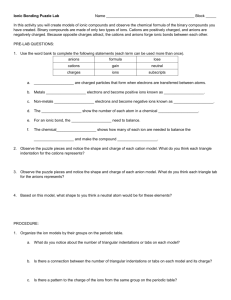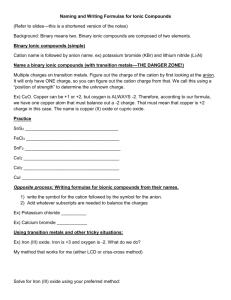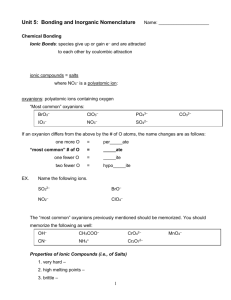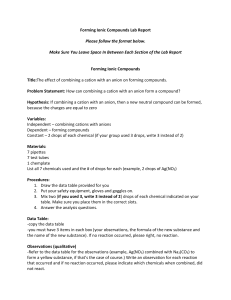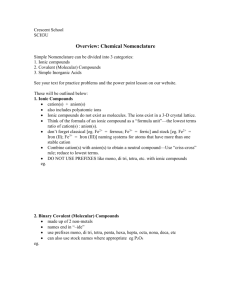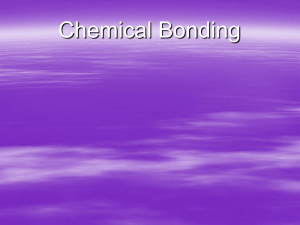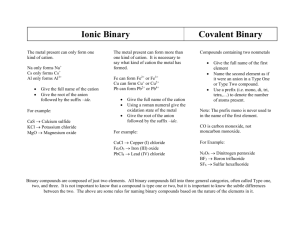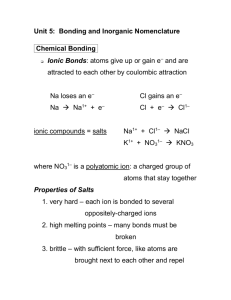Unit 5 Bonding and Inorganic Nomenclature
advertisement
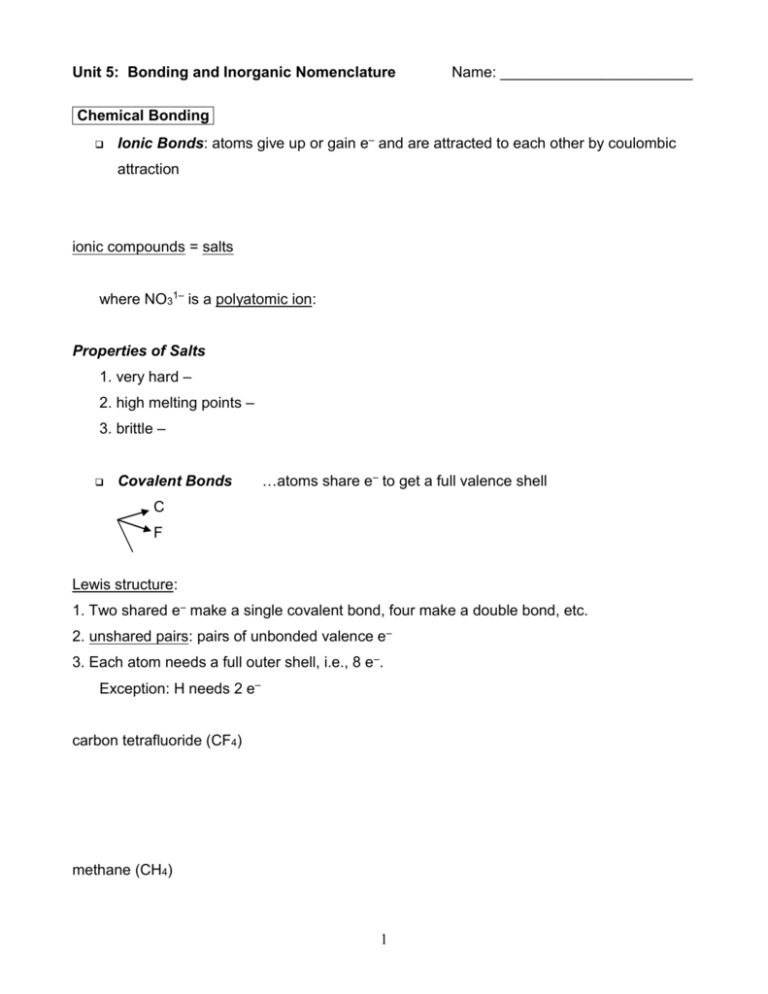
Unit 5: Bonding and Inorganic Nomenclature Name: _______________________ Chemical Bonding Ionic Bonds: atoms give up or gain e– and are attracted to each other by coulombic attraction ionic compounds = salts where NO31– is a polyatomic ion: Properties of Salts 1. very hard – 2. high melting points – 3. brittle – Covalent Bonds …atoms share e– to get a full valence shell C F Lewis structure: 1. Two shared e– make a single covalent bond, four make a double bond, etc. 2. unshared pairs: pairs of unbonded valence e– 3. Each atom needs a full outer shell, i.e., 8 e–. Exception: H needs 2 e– carbon tetrafluoride (CF4) methane (CH4) 1 nitrogen triiodide (NI3) carbon dioxide (CO2) covalent compounds = molecular compounds -- have lower melting points than do ionic compounds In metals, valence shells of atoms overlap, so v.e– Metallic Bonds are free to travel between atoms through material. Properties of Metals Other Types of Bonds dipole-dipole forces, hydrogen bonds, London dispersion forces; & ion-dipole forces Writing Formulas of Ionic Compounds chemical formula: To write an ionic compound’s formula, we need: 1. the two types of ions 2. the charge on each ion criss-cross rule: Na1+ and F1– Ba2+ and O2– Na1+ and O2– Ba2+ and F1– charge on cation / anion “becomes” subscript of anion / cation ** Warning: Al3+ and O2– Ba2+ and S2– In3+ and Br1– 2 Writing Formulas w/Polyatomic Ions Parentheses are required only when you need more than one “bunch” of a particular polyatomic ion. Ba2+ and SO42– Mg2+ and NO21– NH41+ and ClO31– Sn4+ and SO42– Fe3+ and Cr2O72– NH41+ and N3– Inorganic Nomenclature Ionic Compounds (cation/anion combos) Single-Charge Cations with Elemental Anions The single-charge cations are: A. To name, given the formula: 1. Use name of cation. 2. Use name of anion (it has the ending “ide”). NaF BaO Na2O BaF2 B. To write formula, given the name: 1. Write symbols for the two types of ions. 2. Balance charges to write formula. silver sulfide zinc phosphide calcium iodide 3 Multiple-Charge Cations with Elemental Anions The multiple-charge cations are: A. To name, given the formula: 1. Figure out charge on cation. 2. Write name of cation. 3. Write Roman numerals in ( ) to show cation’s charge. 4. Write name of anion. FeO Fe2O3 CuBr CuBr2 B. To find the formula, given the name: 1. Write symbols for the two types of ions. 2. Balance charges to write formula. cobalt (III) chloride tin (IV) oxide Compounds Containing Polyatomic Ions Insert name of ion where it should go in the compound’s name. Write formulas: iron (III) nitrite ammonium phosphide ammonium chlorate zinc phosphate lead (II) permanganate Write names: (NH4)2S2O3 AgBrO3 (NH4)3N U(CrO4)3 Cr2(SO3)3 4 tin (II) oxide Covalent Compounds -- contain two types of nonmetals Key: What to do: Use Greek prefixes to indicate 1– 6– how many atoms of each element, 2– 7– but don’t use “mono” on first element. 3– 8– 4– 9– 5– 10 – EXAMPLES: carbon dioxide CO dinitrogen trioxide N2O5 carbon tetrachloride NI3 Traditional System of Nomenclature …used historically (and still some today) to name compounds w/multiple-charge cations To use: 1. Use Latin root of cation. 2. Use -ic ending for higher charge; “ -ous ending for lower charge 3. Then say name of anion, as usual. Element Latin root -ic -ous gold, Au aur- Au3+ Au1+ lead, Pb plumb- Pb4+ Pb2+ tin, Sn stann- Sn4+ Sn2+ copper, Cu cupr- Cu2+ Cu1+ iron, Fe ferr- Fe3+ Fe2+ Write formulas: Write names: cuprous sulfide Pb3P4 auric nitride Pb3P2 ferrous fluoride SnCl4 5 Empirical Formula and Molecular Formula Compound Molecular Formula glucose C6H12O6 propane C3H8 butane C4H10 naphthalene C10H8 sucrose C12H22O11 octane C8H18 6 Empirical Formula
